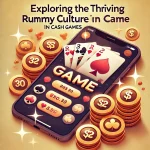The Complete Study of Rummy: A Game for All Ages The card game rummy has been a favorite among players for centuries & has a long & varied history that dates back to the early 1800s. Although its exact origins are still a little unclear, it is generally accepted that the game developed from earlier card games like the Mexican-originated Conquian. Conquian, which uses similar card-melding techniques to create sets and runs, is frequently considered the forerunner of contemporary rummy.
The wide variety of rummy variations that exist today is the result of the game’s multiple adaptations as it traveled across borders. Rummy arrived in the United States by the late 1800s, where it quickly became a household name & greatly popularized in social circles. As rummy developed further, it took on different forms, each with its own distinct set of rules and tactics. One of the game’s most alluring aspects is its versatility, which enables it to speak to a variety of communities & cultures. Variants that offered different gameplay experiences, like Gin Rummy and Indian Rummy, started to appear by the early 20th century.
As mass media & leisure activities emerged, rummy gained popularity, becoming a favorite past time during & after the Great Depression. Rummy has evolved from a simple game to a multigenerational cultural phenomenon that unites people in clubs, homes, and online. There are numerous variations of rummy to suit varying tastes and skill levels, so it’s not a single game. Gin Rummy, which was created in the early 20th century & immediately became popular in the US, is one of the most well-known variations. In Gin Rummy, players try to minimize the number of points in their unmelded cards while forming sets and runs.
Usually played in pairs, the game prioritizes skill and strategy over chance. It’s an exciting game of wits that can result in fierce competition because players have to carefully consider their draws and discards. Indian Rummy, which has become a cultural mainstay in India and among Indian communities around the world, is another popular variation. Compared to Gin Rummy, this variant can accommodate more players and usually uses two decks of cards. Players must declare their hands once they satisfy certain requirements in Indian Rummy, which places a strong emphasis on creating legitimate sets & sequences. The game is interesting and difficult since it frequently includes elements of strategic discarding and deft bluffing.
Because of its widespread appeal, Indian Rummy has become a popular pastime, with many online platforms allowing players to compete against one another. The impact of rummy is not limited to card tables; it has entered popular culture and can be found in a variety of media, such as television series, films, and books. Rummy is frequently used in movies as a setting for character or story development. For example, rummy games are often used in old Bollywood movies as a way for characters to connect or work out disputes. Because the game is social, it’s a perfect storytelling tool that lets filmmakers explore themes of strategy, rivalry, and camaraderie in a short amount of time.
Rummy has also been adopted as a recurrent theme in television programs. In order to entertain viewers and highlight the competitive nature of the game, rummy tournaments or casual games between contestants are a common feature of reality shows. Also, rummy has been incorporated into stories in literature without hesitation. Rummy strategies can reflect the decisions people make in their personal lives, which is why authors frequently use the game as a metaphor for the complexity of life.
This diverse portrayal of rummy in popular culture highlights the fact that it is more than just a game; it is a reflection of social dynamics and interpersonal relationships. Rummy’s simplicity & adaptability, which enable players from a wide range of backgrounds to play, are the reasons for its widespread appeal. As the game spread throughout continents, it adjusted to local tastes and customs, creating distinctive variants that speak to various cultural contexts. A variant known as “Canastra” has become extremely popular in nations like Brazil, for instance, and has its own set of rules and tactics that set it apart from conventional rummy. In a similar vein, “Koi-Koi” in Japan blends aspects of rummy with novel scoring and gameplay features. The spread of rummy throughout the world has been aided by technological advancements.
Players from all over the world can now interact and compete in real time thanks to online gaming platforms. Along with growing the player base, this digital revolution has helped fans who are passionate about the game feel more connected to one another. Rummy’s ability to cross geographic boundaries & continue to develop in the digital age guarantees that it will continue to be a popular past time for many generations to come. Rummy has a thriving and dynamic competitive scene, with many tournaments hosted globally that draw players of all skill levels.
From neighborhood get-togethers at community centers to major international competitions with sizeable cash prizes, these contests cover a wide spectrum. Knockout rounds and round-robin play are two common tournament formats that let competitors show off their skills against strong opponents. The excitement of competition gives the game a thrilling new dimension & turns casual play into a fierce contest of strategy & mental toughness. Online platforms, in addition to conventional tournaments, have transformed competitive rummy by holding virtual tournaments that enable players from all over the world to compete without regard to location.
To improve the competitive experience, these online tournaments frequently include leaderboards, rankings, and real-time updates. While practicing their skills against a variety of opponents, players can participate in friendly games or high-stakes matches. Competitive rummy has gained more recognition as a result of the growth of e-sports; some events are now broadcast live to audiences around the globe, further establishing the game as a respectable competitive activity. Playing rummy with friends or participating in official tournaments requires a good understanding of etiquette. Respect for other players is a basic component, which includes paying attention while playing and avoiding distractions like excessive talking or using mobile devices.
In order to foster an environment that supports fair play, players should also be aware of their facial expressions and body language. Adhering strictly to the game’s rules is also crucial because doing so guarantees fairness and improves everyone’s overall experience. Proper card handling is another essential aspect of rummy etiquette. Players should refrain from showing their cards too much or acting in any way that can be interpreted as dishonest or unsportsmanlike. It is imperative that all participants can clearly see how cards are discarded or drawn from the deck.
Also, players should be kind regardless of their results; praising opponents’ abilities & congratulating them on their accomplishments promotes unity among gamers. Players can maintain a respectful & pleasurable rummy experience by following these rules. There are many cognitive advantages to playing rummy that enhance mental health and general wellbeing. Players of this strategic card game must use critical thinking abilities to evaluate their hands and make decisions based on the information at hand.
This mental workout improves cognitive abilities like memory retention, problem-solving skills, and strategic planning by increasing brain activity. According to research, playing mentally challenging games like rummy on a regular basis can help lower the risk of cognitive decline in older people. Rummy is also a great social game that helps players build relationships with one another.
When playing in groups or pairs, interacting with other players during gameplay promotes cooperation & improves communication skills. In today’s fast-paced world, where many people may feel cut off from their communities, the social interaction that rummy fosters can help reduce feelings of loneliness or isolation. Rummy becomes a holistic activity that promotes emotional and cognitive well-being by fusing social interaction with mental stimulation.
Rummy is well-positioned to continue evolving in response to shifting social trends and technological breakthroughs as we move toward the future. The popularity of mobile applications has revolutionized how people enjoy this age-old hobby by making it simpler than ever for players to access rummy games at any time or location. These applications frequently include cutting-edge features like beginner tutorials, modifiable game settings, and social networking features that let users connect with friends or face off against opponents from around the world. Also, by offering individualized experiences catered to each player’s skill level, artificial intelligence (AI) is transforming gameplay through its integration into online rummy platforms.
AI-powered rivals can successfully test players while providing advice on tactics that improve educational opportunities. We might even see immersive rummy experiences that mimic the experience of playing at a real table with friends or family as virtual reality (VR) technology advances, bridging the gap between traditional gameplay & contemporary technology. Rummy is destined to not only survive but flourish as a popular game for upcoming generations with these developments.
In conclusion, rummy’s timeless appeal as a beloved card game across the globe can be attributed to its rich history, variety of variations, cultural significance, global appeal, competitive landscape, etiquette guidelines, cognitive benefits, and future potential. Rummy remains a timeless classic in the world of gaming, captivating people of all ages whether it is played competitively on global stages or casually among friends.




